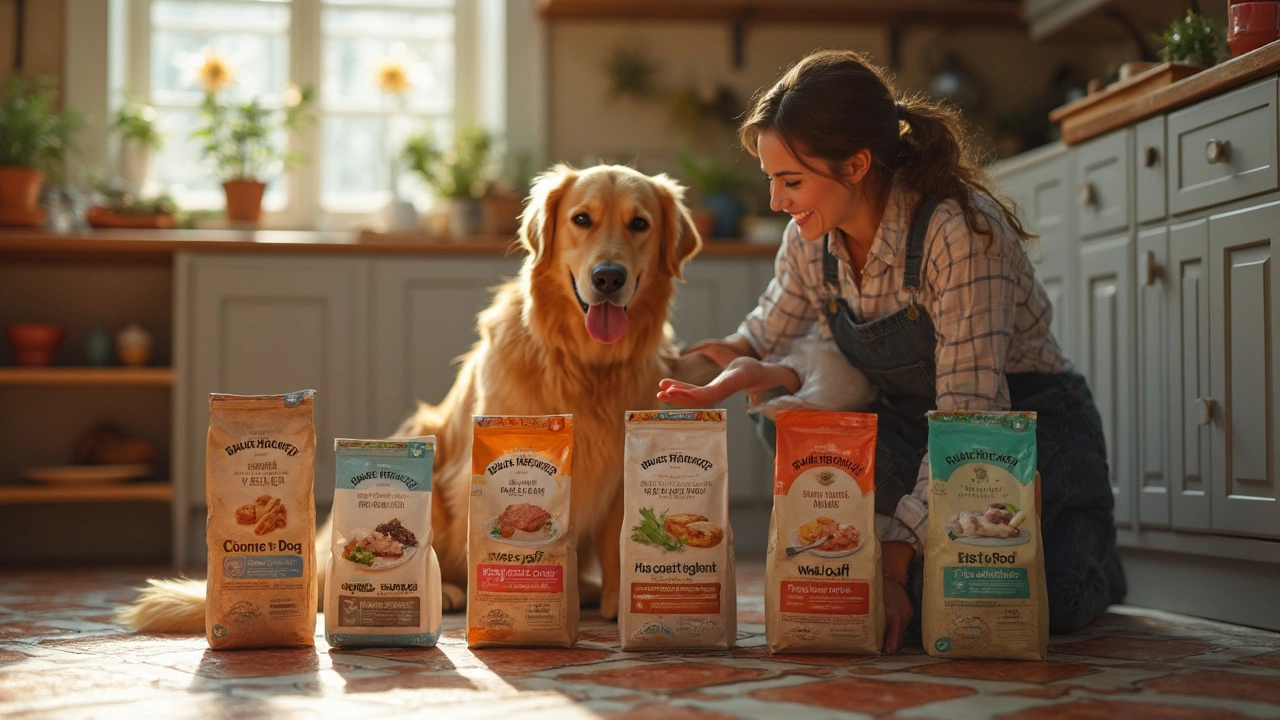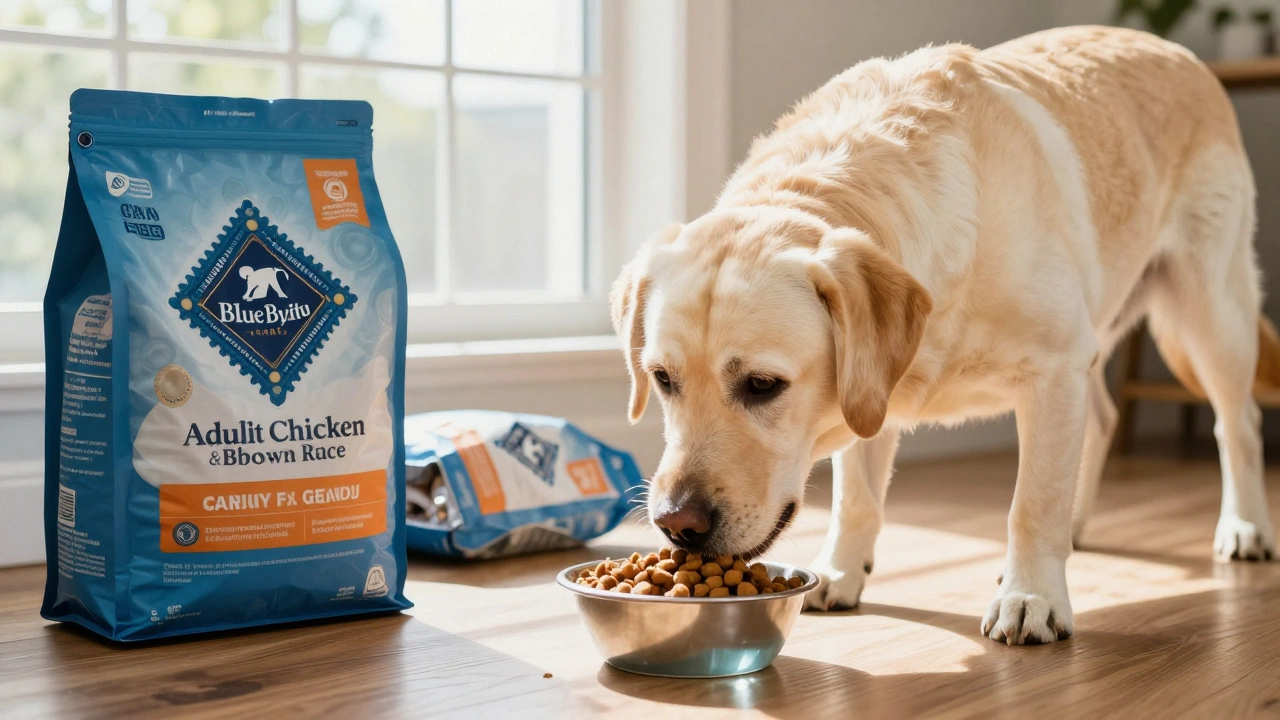Standing in the dog food aisle can feel like trying to crack a secret code. Every bag shouts about being 'premium,' 'holistic,' or 'custom blend,' but none of that really matters if you don't know what should actually be first on the ingredient list. The funny thing? The first ingredient is what your dog's food is mostly made of.
If you flip the bag and see a whole meat, like chicken or beef, right at the top, you're on the right track. Dogs, by nature, are built to thrive on animal protein, not corn or mystery by-products. Real meat leads to stronger muscles, more energy for walks, and even a shinier coat. Forget what the marketing tells you—the facts back up animal-based protein as the gold standard.
But it’s not just about picking any bag with the word 'chicken' slapped on it. You want chicken, beef, or salmon—words you would actually recognize in your own kitchen. When it reads 'corn meal' or 'soybean,' your dog is basically getting cheap filler. These don't power up their bodies the way a real protein source does. So, before you grab that next bag, make sure real, whole meat is listed at number one.
- Why the First Ingredient Matters
- Meat as a Top Ingredient: The Science
- Different Types of Protein and Their Impact
- Reading Dog Food Labels: Tips and Tricks
- What to Avoid in the Ingredient List
Why the First Ingredient Matters
If you’ve ever checked a dog food label, you might notice the ingredients list starts with one key item. That top spot isn’t random—it shows what makes up most of the recipe by weight in its raw form. Whatever’s listed first is what your dog will be eating the most of, which is why you can’t ignore it.
Choosing the right first ingredient heavily impacts your dog’s health. If it’s high-quality animal protein, you’re giving your dog exactly what its body craves. Studies show dogs rely on real meat to keep their muscles strong, immune systems in shape, and energy levels high. If that first spot is filled by grains or fillers, your dog just isn’t getting the nutrition it needs.
| Top 3 First Ingredients | Impact on Health | Common in Brands |
|---|---|---|
| Whole Meat (e.g., chicken, beef, fish) | Best for muscle, coat, overall energy | Premium & quality brands |
| Meat Meals (e.g., chicken meal) | Good protein, often more concentrated than whole meat | Mid-range & quality brands |
| Grains/Fillers (corn, soy, wheat) | Cheap filler, not optimal for health | Budget brands |
Dog owners often think more expensive means better, but watch out—some fancy brands still stick grains or "meat by-product" as their number one. That’s a warning sign. Always look for:
- Specific, real animal proteins (like chicken, beef, or salmon) as the first ingredient
- No vague terms like 'animal digest' or 'meat derivatives'
- Short ingredient lists with words you actually know
Choosing food with dog food where whole meat leads the list gives your pup the nutrients it really needs, not just what fills its belly.
Meat as a Top Ingredient: The Science
Lining up a bag of dog food with meat as the first ingredient isn't just good marketing—it's real science. Dogs are not wolves, but their bodies still crave animal protein. The reason? Their digestive systems handle meat proteins and fats way better than plant stuff like corn or wheat. If your dog gets most of its nutrition from meat, you’re feeding them what they’re meant to use for muscle, energy, and repair.
Multiple studies have shown dogs build muscle faster and keep a healthy weight on diets where meat tops the chart. For example, research published by the Journal of Animal Science found that dogs digest and absorb protein from chicken, beef, and fish much more easily than from soy or corn. Less digestible protein means more poop and less actual nutrition getting into your dog’s system.
Check out this quick table that breaks down protein digestibility in dogs by source:
| Protein Source | Digestibility (%) |
|---|---|
| Chicken | 92 |
| Beef | 89 |
| Fish | 88 |
| Soy | 78 |
| Corn Gluten | 72 |
The difference is clear—meat proteins actually get used by your dog's body, while plant proteins mostly take a trip straight through. You’ll see the results in better energy, muscle, and even fewer issues like itching or digestive troubles.
Don’t just take the bag’s word for it, though. Those lists can be sneaky. If you spot words like “chicken meal” or “animal by-product,” realize these aren’t the same as whole meat. Whole, named meats are your best *dog food* bet. Always double-check the ingredient list while keeping in mind what really fuels your dog’s health.

Different Types of Protein and Their Impact
Not all proteins are created equal when it comes to dog food. You’ve probably noticed chicken, beef, lamb, fish, and sometimes even duck on those labels. Each of these sources brings something different to the bowl, so choosing the right one isn’t just a random pick—it’s about what keeps your dog healthy, strong, and full of energy.
Here’s a breakdown of the most common protein types you’ll see in dog foods and how they stack up:
- Chicken: Lean, affordable, and easy to digest. It’s packed with the amino acids dogs need but can trigger allergies in some pups.
- Beef: Filling and rich in iron and zinc, which help boost energy and maintain muscle. Some dogs handle beef better than chicken, especially if allergies are an issue.
- Fish (like salmon or whitefish): Loaded with omega-3 fatty acids that support a shiny coat and soothe itchy skin. Fish-based foods are often a good pick for dogs with sensitive stomachs.
- Lamb: Often used in dog food for pups with allergies because it’s less common. It’s high in protein and easy on digestion but can be a bit pricier.
- Egg: Extremely digestible and a source of complete protein. Great for building muscle, but not always found as the main ingredient.
What matters most with dog food is quality and digestibility. A 2023 survey from the Pet Food Institute found that dogs fed real meat as their main protein had shinier coats and 12% more lean body mass compared to those getting mostly grain-based or plant-based protein. Taste matters too—most dogs simply prefer real meat flavors, so you’ll likely have less food left in the bowl.
| Protein Source | Digestibility Score (%) | Key Benefit |
|---|---|---|
| Chicken | 92 | Muscle support, easy to digest |
| Beef | 87 | Iron and energy |
| Salmon | 89 | Omega-3 for skin and coat |
| Lamb | 85 | Gentle on the stomach |
| Egg | 98 | Building muscle, top digestibility |
Plant proteins like peas or lentils sometimes show up, but they just don’t do the same job as animal proteins. Dogs process animal proteins better. If your dog has food sensitivities, consider a limited-ingredient food with a protein they haven’t tried before, like duck or fish. For dogs with no allergies, rotating between a couple of different animal proteins can cover all bases when it comes to nutrition.
Reading Dog Food Labels: Tips and Tricks
Dog food labels can be pretty sneaky. They’re filled with official-sounding terms but don’t always tell you what you need to know. The first stop? Always check the ingredient list. The rules say that ingredients are listed by weight, so whatever’s listed first is the main thing going into your dog’s bowl.
If you spot 'chicken,' 'beef,' or 'salmon' as the first ingredient, that's what you want to see. But here’s a trick: if it says 'chicken meal,' don’t panic. 'Meal' just means the moisture’s been removed, so it's even more concentrated. The shady stuff starts when words like 'by-product,' 'corn,' or 'wheat' show up early—these are cheap fillers and not real sources of quality nutrition.
According to the Association of American Feed Control Officials (AAFCO), "products listing whole meats first usually provide better quality protein than products where grains top the list."
Keep your eyes peeled for:
- Short ingredient lists. Fewer, straightforward ingredients usually means less junk.
- No mystery meat. If it just says 'meat' or 'animal fat,' move on—the source should be clear.
- Added veggies and named fats like 'chicken fat,' which provide extra nutrients and healthy energy.
Ignore the fancy packaging and buzzwords. The *dog food* ingredient list tells the real story about what's feeding your pup. Flip the bag, read closely, and you’ll make a smarter pick—every single time.

What to Avoid in the Ingredient List
When it comes to dog food, knowing what shouldn’t show up on the label is just as important as knowing what's good. Not all ingredients work in your dog's favor. Some are just cheap shortcuts companies use to save money, and your dog's health ends up paying the price.
One red flag is vague meat ingredients, like “meat by-product” or “animal digest.” These are basically the leftovers that aren’t good enough for your grocery store chicken or beef—think feet, necks, and random parts. They're not the kind of protein you want fueling your dog. Always go for foods that list a specific whole meat like “chicken” or “beef,” not the mystery meat stuff.
Fillers are another thing to watch out for. Ingredients like corn, wheat, or soy usually show up because they’re cheap, not because they add any real nutrition. Sure, they might keep your dog feeling full, but they won’t provide lasting energy, strong muscles, or a glossy coat.
Artificial additives are trouble too. Things like artificial colors, flavors, and chemical preservatives (such as BHA, BHT, and ethoxyquin) don’t help your dog at all—if anything, they can make things worse. Studies have linked some of these preservatives to health problems, so it’s safer to avoid them altogether. Stick with dog foods that use natural preservatives like mixed tocopherols (basically vitamin E), which are way safer.
Watch out for added sugars as well. Dogs don’t need sugar, and adding it is just a shortcut to get your dog hooked on the taste. Look for words like “corn syrup,” “caramel,” or “sugar” itself—they have no place in a good dog food.
- Choose dog foods where the first ingredient is a whole, named protein.
- Avoid foods with “by-product” or “meal” that isn’t clearly labeled from a single animal source.
- Skip products with cheap fillers like corn, wheat, or soy high up on the list.
- Say no to artificial colors, flavors, and preservatives.
- Steer clear of any added sugars or sweeteners.
Quick rule: if you can’t easily recognize or pronounce the first few ingredients, it’s better not to put it in your dog’s bowl. Your best bet? A simple, honest label full of ingredients that make sense—and that start with real, named protein.









